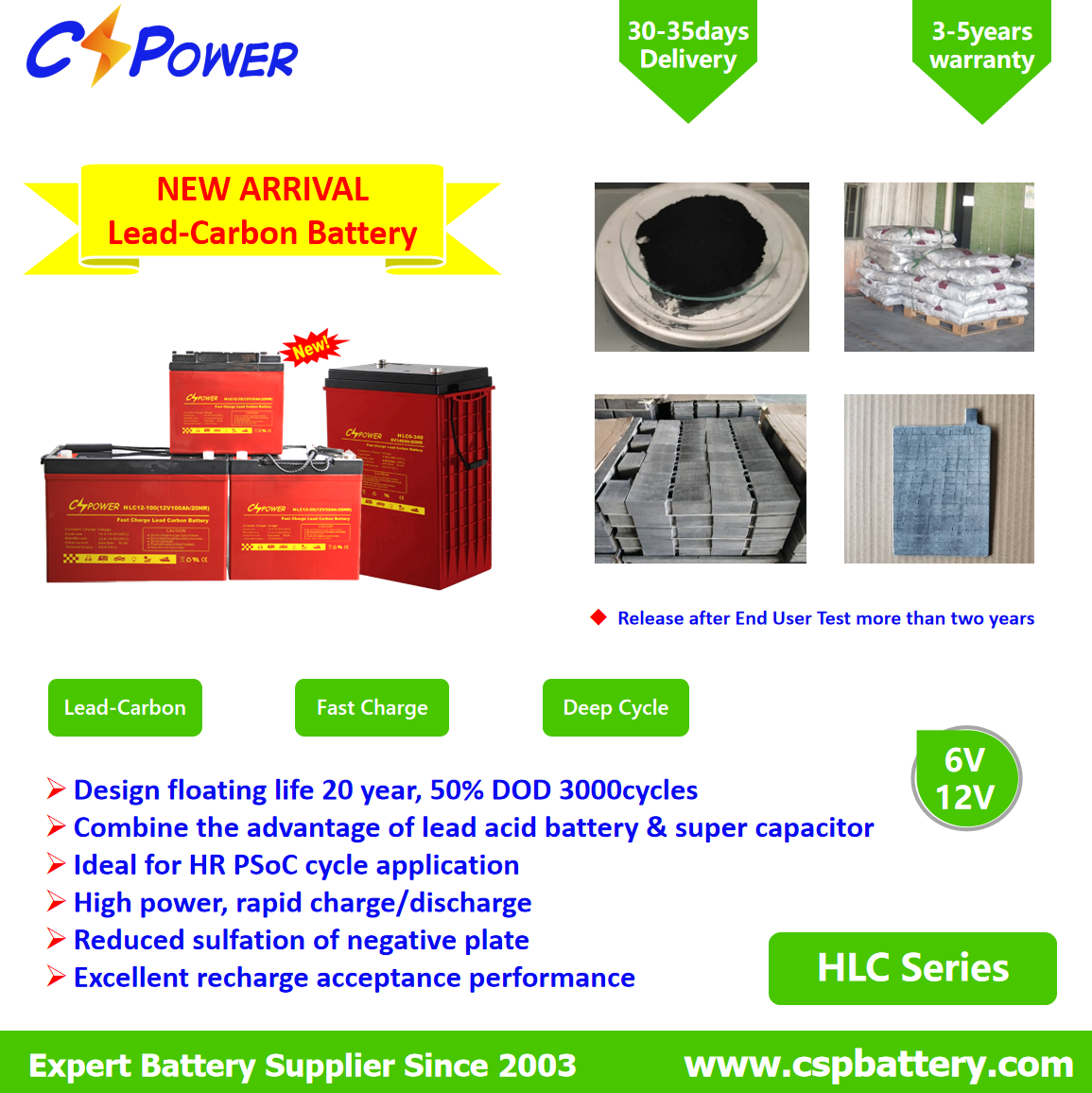סוללת עופרת פחמן CSPower – טכנולוגיה, יתרונות
עם התקדמות החברה, הדרישות לאגירת אנרגיה של סוללות באירועים חברתיים שונים ממשיכות לעלות. בעשורים האחרונים, טכנולוגיות סוללות רבות עשו התקדמות רבה, ופיתוח סוללות עופרת-חומצה נתקל גם בהזדמנויות ובאתגרים רבים. בהקשר זה, מדענים ומהנדסים עבדו יחד כדי להוסיף פחמן לחומר הפעיל השלילי של סוללות עופרת-חומצה, וסוללת העופרת-פחמן, גרסה משודרגת של סוללות עופרת-חומצה, נולדה.
סוללות עופרת-פחמן הן סוג מתקדם של סוללות עופרת-חומצה מווסתות שסתום, המשתמשות בקתודה העשויה מפחמן ואנודה העשויה מעופרת. הפחמן בקתודה העשויה מפחמן מבצע את תפקידו של קבל או 'סופר-קבל' המאפשר טעינה ופריקה מהירות יחד עם אורך חיים מוארך בשלב הטעינה הראשוני של הסוללה.
למה השוק צריך סוללת עופרת פחמן???
- * מצבי כשל של סוללות עופרת חומצה VRLA שטוחות במקרה של מחזורי הפעלה אינטנסיביים
מצבי הכשל הנפוצים ביותר הם:
– ריכוך או נשירה של החומר הפעיל. במהלך הפריקה, תחמוצת העופרת (PbO2) של הלוח החיובי הופכת לעופרת גופרתית (PbSO4), וחזרה לתחמוצת עופרת במהלך הטעינה. מחזורי טעינה תכופים יפחיתו את הלכידות של חומר הלוח החיובי עקב נפח העופרת גופרתית הגבוה יותר בהשוואה לתחמוצת עופרת.
– קורוזיה של רשת הלוח החיובי. תגובת קורוזיה זו מואצת בסוף תהליך הטעינה עקב נוכחותה ההכרחית של חומצה גופרתית.
– סולפציה של החומר הפעיל של הלוח השלילי. במהלך הפריקה, העופרת (Pb) של הלוח השלילי הופך גם הוא לעופרת גופרתית (PbSO4). כאשר הם נשארים במצב מטען נמוך, גבישי העופרת גופרתית על הלוח השלילי גדלים ומתקשים ויוצרים שכבה בלתי חדירה שלא ניתן להמיר אותה בחזרה לחומר פעיל. התוצאה היא ירידה בקיבולת, עד שהסוללה הופכת לחסרת תועלת.
- * לוקח זמן לטעון סוללת עופרת חומצה
באופן אידיאלי, יש לטעון סוללת עופרת חומצה בקצב שאינו עולה על 0.2 מעלות צלזיוס, ושלב הטעינה הכולל צריך להיות שמונה שעות של טעינת ספיגה. הגדלת זרם הטעינה ומתח הטעינה יקצרו את זמן הטעינה על חשבון חיי שירות קצרים עקב עליית הטמפרטורה וקורוזיה מהירה יותר של הלוח החיובי עקב מתח טעינה גבוה יותר.
- * פחמן עופרת: ביצועי מצב טעינה חלקיים טובים יותר, יותר מחזורי טעינה ארוכים יותר, ויעילות גבוהה יותר במחזור עמוק
החלפת החומר הפעיל של הלוח השלילי בקומפוזיט של פחמן עופרת מפחיתה באופן פוטנציאלי את הסולפטציה ומשפרת את קליטת המטען של הלוח השלילי.
טכנולוגיית סוללות עופרת-פחמן
רוב הסוללות הנמצאות בשימוש מציעות טעינה מהירה תוך שעה או יותר. למרות שהסוללות נמצאות במצב טעינה, הן עדיין יכולות לספק אנרגיית פלט, מה שהופך אותן לפעילות גם במצב טעינה, מה שמגדיל את השימוש בהן. עם זאת, הבעיה שהתעוררה בסוללות עופרת-חומצה הייתה שהפריקה שלהן הייתה קצרה מאוד והטעינה החוזרת ארוכה מאוד.
הסיבה לכך שלסוללות עופרת-חומצה לקח כל כך הרבה זמן לחזור לטעינה המקורית שלהן הייתה שאריות של עופרת גופרתי ששקעו על האלקטרודות של הסוללה ורכיבים פנימיים אחרים. זה דרש איזון לסירוגין של הסולפט מהאלקטרודות ומרכיבי הסוללה האחרים. שקיעה זו של עופרת גופרתי מתרחשת עם כל מחזור טעינה ופריקה, ועודף האלקטרונים עקב משקעים גורם לייצור מימן וכתוצאה מכך לאובדן מים. בעיה זו גוברת עם הזמן ושאריות הסולפט מתחילות ליצור גבישים אשר הורסים את יכולת קליטת המטען של האלקטרודה.
האלקטרודה החיובית של אותה סוללה מניבה תוצאות טובות למרות שיש בה את אותם משקעי עופרת גופרתית, מה שמבהיר שהבעיה טמונה באלקטרודה השלילית של הסוללה. כדי להתגבר על בעיה זו, מדענים ויצרנים פתרו בעיה זו על ידי הוספת פחמן לאלקטרודה השלילית (קתודה) של הסוללה. הוספת הפחמן משפרת את קליטת המטען של הסוללה, ובכך מבטלת את הטעינה החלקית וההזדקנות של הסוללה עקב שאריות עופרת גופרתית. על ידי הוספת פחמן, הסוללה מתחילה להתנהג כ"סופר-קבל" המציע את תכונותיו לביצועים טובים יותר של הסוללה.
סוללות עופרת-פחמן הן תחליף מושלם ליישומים הכוללים סוללות עופרת-חומצה, כמו יישומי התנעה-עצירה תכופים ומערכות היברידיות מיקרו/קלות. סוללות עופרת-פחמן יכולות להיות כבדות יותר בהשוואה לסוגים אחרים של סוללות, אך הן חסכוניות, עמידות לטמפרטורות קיצוניות ואינן דורשות מנגנוני קירור כדי לעבוד לצידן. בניגוד לסוללות עופרת-חומצה מסורתיות, סוללות עופרת-פחמן אלו פועלות בצורה מושלמת בין 30 ל-70 אחוז קיבולת טעינה ללא חשש משקעי סולפט. סוללות עופרת-פחמן עלו על סוללות העופרת-חומצה ברוב הפונקציות, אך הן סובלות מירידת מתח בפריקה כמו שקורה לסופר-קבל.
בנייה עבורCSPowerסוללת עופרת פחמן טעינה מהירה עמוקה
תכונות עבור סוללת עופרת פחמן טעינה מהירה עמוקה
- שלב את המאפיינים של סוללת עופרת חומצה וקבל-על
- תכנון שירות מחזור חיים ארוך, PSoC מעולה וביצועים מחזוריים
- l עוצמה גבוהה, טעינה ופריקה מהירות
- עיצוב ייחודי של רשת והדבקת עופרת
- סבילות קיצונית לטמפרטורה
- מסוגל לפעול בטמפרטורה של -30°C -60°C
- יכולת התאוששות מפריקה עמוקה
יתרונות לסוללת עופרת פחמן לטעינה מהירה
לכל סוללה יש את השימוש הייעודי שלה בהתאם ליישומים שלה, ולא ניתן לכנותה טובה או רעה באופן כללי.
סוללת עופרת-פחמן אולי אינה הטכנולוגיה החדישה ביותר לסוללות, אך היא מציעה כמה יתרונות גדולים שאפילו טכנולוגיות הסוללה החדישות אינן יכולות להציע. כמה מהיתרונות של סוללות עופרת-פחמן מפורטים להלן:
- פחות גופרתי במקרה של פעולה במצב מטען חלקי.
- מתח טעינה נמוך יותר ולכן יעילות גבוהה יותר ופחות קורוזיה של הלוח החיובי.
- והתוצאה הכוללת היא שיפור מחזור החיים.
בדיקות הראו שסוללות עופרת-פחמן שלנו אכן עומדות בלפחות שמונה מאות מחזורי הגנה מפני נזק של 100%.
הבדיקות כוללות פריקה יומית ל-10.8V עם I = 0.2C₂₀, כשעתיים מנוחה במצב פריק, ולאחר מכן טעינה מחדש עם I = 0.2C₂₀.
- l ≥ 1200 מחזורים @ 90% DoD (פריקה ל-10.8V עם I = 0.2C₂₀, מנוחה של כשעתיים במצב פריק, ולאחר מכן טעינה מחדש עם I = 0.2C₂₀)
- l ≥ 2500 מחזורים @ 60% DoD (פריקה במשך שלוש שעות עם I = 0,2C₂₀, מיד על ידי טעינה מחדש ב-I = 0,2C₂₀)
- l ≥ 3700 מחזורים @ 40% DoD (פריקה במשך שעתיים עם I = 0,2C₂₀, מיד על ידי טעינה מחדש ב-I = 0,2C₂₀)
- השפעת הנזק התרמי בסוללות עופרת-פחמן מינימלית בשל תכונות הטעינה-פריקה שלהן. תאים בודדים רחוקים מסיכוני שריפה, פיצוץ או התחממות יתר.
- סוללות עופרת-פחמן מתאימות באופן מושלם למערכות מחוברות לרשת החשמל ומחוץ לרשת החשמל. איכות זו הופכת אותן לבחירה טובה עבור מערכות חשמל סולאריות מכיוון שהן מציעות יכולת זרם פריקה גבוהה.
סוללות עופרת פחמןVSסוללת עופרת חומצה אטומה, סוללות ג'ל
- סוללות עופרת-פחמן מתפקדות טוב יותר במצבי טעינה חלקיים (PSOC). סוללות עופרת רגילות פועלות בצורה הטובה ביותר ומחזיקות מעמד זמן רב יותר אם הן פועלות לפי משטר קפדני של 'טעינה מלאה'-'פריקה מלאה'-טעינה מלאה'; הן אינן מגיבות היטב לטעינה בכל מצב בין מלא לריק. סוללות עופרת-פחמן מתפקדות טוב יותר באזורי טעינה מעורפלים יותר.
- סוללות עופרת-פחמן משתמשות באלקטרודות שליליות מסוג סופר-קבל. סוללות פחמן משתמשות באלקטרודה חיובית סטנדרטית מסוג עופרת ואלקטרודה שלילית מסוג סופר-קבל. אלקטרודת סופר-קבל זו היא המפתח לאריכות החיים של סוללות הפחמן. אלקטרודה סטנדרטית מסוג עופרת עוברת תגובה כימית לאורך זמן מטעינה ופריקה. האלקטרודה השלילית מסוג סופר-קבל מפחיתה קורוזיה על האלקטרודה החיובית וזה מוביל לחיי סוללה ארוכים יותר של האלקטרודה עצמה, מה שמוביל לסוללות בעלות עמידות ארוכת טווח.
- לסוללות עופרת-פחמן יש קצבי טעינה/פריקה מהירים יותר. לסוללות עופרת סטנדרטיות יש קצב טעינה/פריקה מקסימלי של בין 5-20% מהקיבולת המדורגת שלהן, כלומר ניתן לטעון או לפרוק את הסוללות בין 5 ל-20 שעות מבלי לגרום נזק לטווח ארוך ליחידות. לסוללות עופרת-פחמן יש קצב טעינה/פריקה תיאורטי בלתי מוגבל.
- סוללות עופרת-פחמן אינן דורשות תחזוקה כלשהי. הסוללות אטומות לחלוטין ואינן דורשות תחזוקה פעילה.
- סוללות עופרת-פחמן הן תחרותיות מבחינת עלות לעומת סוללות ג'ל. סוללות ג'ל עדיין זולות מעט יותר לרכישה ראשונה, אך סוללות פחמן עולות רק מעט יותר. הפרש המחירים הנוכחי בין סוללות ג'ל לסוללות פחמן הוא בערך 10-11%. קחו בחשבון שפחמן מחזיק מעמד כ-30% יותר זמן וניתן להבין מדוע זוהי אפשרות משתלמת יותר לכסף.
זמן פרסום: 8 באפריל 2022









